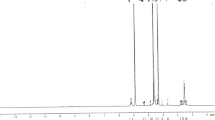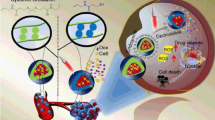Abstract
Purpose
A novel photo-activated targeted chemotherapy was developed by photochemical internalization (PCI) of glutathione-sensitive polymeric micelles incorporating camptothecin (CPT) prepared from thiolated CPT (CPT-DP) and thiolated poly(ethylene glycol)-b-poly(glutamic acid) (PEG-b-P(Glu-DP))
Methods
PEG-b-P(Glu-DP) and CPT-DP were synthesized and characterized by 1H-NMR and gel permeation chromatography, and then mixed to prepare CPT-loaded polymeric micelles (CPT/m). The CPT release from the micelle was studied by reverse phase liquid chromatography. The PCI-activated cytotoxicity of CPT/m against HeLa cells was studied in combination with a non-toxic concentration of dendrimer phthalocyanine-loaded micelles (DPc/m) as the photosensitizer.
Results
The diameter of CPT/m was 96 nm and the drug loading was 20% (w/w). CPT was slowly released under the conditions reproducing the extracellular or endosomal environments. However, under the reductive conditions mimicking the cytosol, CPT was rapidly released achieving approximately 90% of the drug release after 24 h. The cytotoxicity of CPT/m was drastically increased on photoirradiation, whereas the CPT/m were not cytotoxic without PCI.
Conclusions
The CPT/m released the drug responding to reductive conditions. The PCI-induced endosomal escape exposed CPT/m to the cytosol triggering the drug release. Thus, CPT/m in combination with DPc/m will behave as smart nanocarriers activated only at photoirradiated tissues.









Similar content being viewed by others
Abbreviations
- CPT:
-
camptothecin
- CPT-DP:
-
thiolated CPT
- PEG-b-P(Glu-DP):
-
thiolated poly(ethylene glycol)-b-poly(glutamic acid)
- CPT/m:
-
CPT-loaded polymeric micelles
- DLS:
-
dynamic light scattering
- DPc/m:
-
dendrimer phthalocyanine-loaded micelles
- PCI:
-
photochemical internalization
- PDT:
-
photodynamic therapy
- PS:
-
photosensitizer
- SPTDP:
-
disulfide amine linker
- RPLC:
-
reverse phase liquid chromatography
References
N. K. Mal, M. Fujiwara, and Y. Tanaka. Photocontrolled reversible release of guest molecules from coumarin modified mesoporous silica. Nature 421:350–353 (2003). doi:10.1038/nature01362.
A. Mueller, B. Bondurant, and D.F. O’Brien. Visible-light-stimulated destabilization of PEG-liposomes. Macromolecules 33:4799–4804 (2000). doi:10.1021/ma000055l.
B. Bondurant, A. Mueller, and D. F. O’Brien. Photoinitiated destabilization of sterically stabilized liposomes. Biochim. Biophys. Acta. 1511:113–122 (2001). doi:10.1016/S0005-2736(00)00388-6.
J. Lu, E. Choi, F. Tamanoi, and J. I. Zink. Light-activated nanoimpeller-controlled drug release in cancer cells. Small 4:421–426 (2008). doi:10.1002/smll.200700903.
C. P. McCoy, C. Rooney, C. R. Edwards, D. S. Jones, and S. P. Gorman. Light-triggered molecule-scale drug dosing devices. J. Am. Chem. Soc. 129:9572–9573 (2007). doi:10.1021/ja073053q.
K. Berg, P. K. Selbo, L. Prasmickaite, T. E. Tjelle, K. Sandvig, J. Moan, G. Gaudernack, Ø. Fodstad, S. Kjølsrud, H. Anholt, G. H. Rodal, S. K. Rodal, and A. Høgset. Photochemical internalization: a novel technology for delivery of macromolecules into cytosol. Cancer Res. 59:1180–1183 (1999).
P. K. Selbo, K. Sandvig, V. Kirveliene, and K. Berg. Release of gelonin from endosomes and lysosomes to cytosol by photochemical internalization. Biochim. Biophys. Acta. 1475:307–313 (2000).
A. Høgset, L. Prasmickaite, T. E. Tjelle, and K. Berg. Photochemical transfection: a new technology for light-induced, site-directed gene delivery. Hum. Gene Ther. 11:869–880 (2000). doi:10.1089/10430340050015482.
A. Høgset, L. Prasmickaite, P. K. Selbo, M. Hellum, B. Ø. Engesæter, A. Bonsted, and K. Berg. Photochemical internalisation in drug and gene delivery. Adv. Drug Deliv. Rev. 56:95–115 (2004). doi:10.1016/j.addr.2003.08.016.
N. Nishiyama, A. Iriyama, W-D. Jang, K. Miyata, K. Itaka, Y. Inoue, H. Takahashi, Y. Yanagi, Y. Tamaki, H. Koyama, and K. Kataoka. Light-induced gene transfer from packaged DNA enveloped in a dendrimeric photosensitizer. Nat. Mater. 4:934–941 (2005). doi:10.1038/nmat1524.
N. Nishiyama, Arnida, W-D. Jang, K. Date, K. Miyata, and K. Kataoka. Photochemical enhancement of transgene expression by polymeric micelles incorporating plasmid DNA and dendrimer-based photosensitizer. J. Drug Targeting 14:413–424 (2006). doi:10.1080/10611860600834508.
Arnida, N. Nishiyama, W-D. Jang, Y. Yamasaki, and K. Kataoka. Novel ternary polyplex of triblock copolymer, pDNA and anionic dendrimer phthalocyanine for photochemical enhancement of transgene expression. J. Control. Release 116:e75–e77 (2006). doi:10.1016/j.jconrel.2006.09.058.
Arnida, N. Nishiyama, N. Kanayama, W-D. Jang, Y. Yamasaki, and K. Kataoka. PEGylated gene nanocarriers based on block catiomers bearing ethylenediamine repeating units directed to remarkable enhancement of photochemical transfection. J. Control. Release 115:208–215 (2006).
K. R. Weishaupt, C. J. Gomer, and T. J. Dougherty. Identification of singlet oxygen as the cytotoxic agent in photoinactivation of a murine tumor. Cancer Res. 36:2326–2329 (1976).
H. I. Pass. Photodynamic therapy in oncology: mechanisms and clinical use. J. Natl. Cancer Inst. 85:443–456 (1993). doi:10.1093/jnci/85.6.443.
S. B. Brown, E. A. Brown, and I. Walker. The present and future role of photodynamic therapy in cancer treatment. Lancet Oncol. 5:497–508 (2004). doi:10.1016/S1470-2045(04)01529-3.
A. Meister, and M. E. Anderson. Glutathione. Annu. Rev. Biochem. 52:711–760 (1983). doi:10.1146/annurev.bi.52.070183.003431.
K. Kataoka, A. Harada, and Y. Nagasaki. Block copolymer micelles for drug delivery: design, characterization and biological significance. Adv. Drug Deliv. Rev. 47:113–131 (2001). doi:10.1016/S0169-409X(00)00124-1.
R. Duncan. The dawning era of polymer therapeutics. Nature Rev. Drug Discov. 2:347–360 (2003). doi:10.1038/nrd1088.
N. Nishiyama, and K. Kataoka. Current sate, achievements, and future prospects of polymeric micells as nanocarriers for drug and gene delivery. Pharmacol. & Ther. 112:630–648 (2006). doi:10.1016/j.pharmthera.2006.05.006.
A. Lavasanifar, J. Samuel, and G. S. Kwon. Poly(ethylene oxide)-block-poly(L-amino acid) micelles for drug delivery. Adv. Drug Deliv. Rev. 54:169–190 (2002). doi:10.1016/S0169-409X(02)00015-7.
Y. Matsumura, and H. Maeda. A new concept for macromolecular therapeutics in cancer chemotherapy: mechanism of tumoritropic accumulation of proteins and the antitumor agent SMANCS. Cancer Res. 46:6387–6392 (1986).
W-D. Jang, N. Nishiyama, G-D Zhang, A. Harada, D-L Jiang, S. Kawauchi, Y. Morimoto, M. Kikuchi, H. Koyama, T. Aida, and K. Kataoka. Supramolecular nanocarrier of anionic dendrimer porphyrins with cationic block copolymers modified with poly(ethylene glycol) to enhance intracellular photodynamic efficacy. Angew. Chemie., Int. Ed. 117:423–427 (2005). doi:10.1002/ange.200461603.
W-D. Jang, Y. Nakagishi, N. Nishiyama, S. Kawauchi, Y. Morimoto, M. Kikuchi, and K. Kataoka. Polyion complex micelles for photodynamic therapy: Incorporation of dendritic photosensitizer excitable at long wavelength relevant to improved tissue-penetrating property. J Control. Release 113:73–79 (2006). doi:10.1016/j.jconrel.2006.03.009.
J. O’Leary, and F. M. Muggia. Camptothecins: a review of their development and schedules of administration. Eur. J. Cancer 34:1500–1508 (1998). doi:10.1016/S0959-8049(98)00229-9.
B. C. Giovanella, N. Harris, J. Mendoza, Z. Cao, J. Liehr, and J. S. Stehlin. Dependence of anticancer activity of camptothecins on maintaining their lactone function. Ann. New York Acad. Sci. 922:27–35 (2000).
N. Nishiyama, S. Okazaki, H. Cabral, M. Miyamoto, Y. Kato, Y. Sugiyama, K. Nishio, Y. Matsumura, and K. Kataoka. Novel cisplatin-incorporated polymeric micelles can eradicate solid tumors in mice. Cancer Res. 63:8977–8983 (2003).
A. C. H. Ng, X. Li, and D. K. P. Ng. Synthesis and photophysical properties of nonaggregated phthalocyanines bearing dendritic substitutes. Macromolecules 32:5292–5298 (1999). doi:10.1021/ma990367s.
A. Harada, and K. Kataoka. Formation of polyion complex micelles in an aqueous milieu form a pair of oppositely charged block copolymers with poly(ethylene glycol) segments. Macromolecules 28:5294–5299 (1995). doi:10.1021/ma00119a019.
Y. Kakizawa, A. Harada, and K. Kataoka. Environment-sensitive stabilization of core-Shell structured polyion complex micelle by reversible cross-Linking of the core through disulfide bond. J. Am. Chem. Soc. 121:11247–11248 (1999). doi:10.1021/ja993057y.
K. Miyata, Y. Kakizawa, N. Nishiyama, A. Harada, Y. Yamasaki, H. Koyama, and K. Kataoka. Block catiomer polyplexes with regulated densities of charge and disulfide cross-linking directed to enhance gene expression. J. Am. Chem. Soc. 126:2355–2361 (2004). doi:10.1021/ja0379666.
K. Miyata, Y. Kakizawa, N. Nishiyama, Y. Yamasaki, T. Watanabe, M. Kohara, and K. Kataoka. Practically applicable cross-linked polyplex micelle with high tolerability against freeze-drying for in vivo gene delivery. J. Control. Release. 109:15–23 (2005). doi:10.1016/j.jconrel.2005.09.043.
K. Berg, A. Dietze, O. Kaalhus, and A. Høgset. Site-specific drug delivery by photochemical internalization enhances the antitumor effect of Bleomycin. Clin. Cancer Res. 11:8476–8485 (2005). doi:10.1158/1078-0432.CCR-05-1245.
R. Greenwald, A. Pendri, C. Conover, C. Gilbert, R. Yang, and J. Xia. Drug delivery systems. 2. Camptothecin-20-O- poly(ethylene glycol) ester transport forms. J. Med. Chem. 39:1938–1940 (1996). doi:10.1021/jm9600555.
B. B. Lundberg. Biologically active camptothecin derivatives for incorporation into liposome bilayers and lipid emulsions. Anticancer Drug Design. 13:453–461 (1998).
X. Liu, B. C. Lynn, J. Zhang, L. Song, D. Bom, W. Du, D.P. Curran, and T. G. Burke. A versatile prodrug approach for liposomal core-loading of water-insoluble camptothecin anticancer drugs. J. Am. Chem. Soc. 124:7650–7661 (2002). doi:10.1021/ja0256212.
A. Shenderova, T. G. Burke, and S. P. Schwendeman. Stabilization of 10-hydroxycamptothecin in poly(lactide-co-glycolide) microsphere delivery vehicles. Pharm. Res. 14:1406–1414 (1997). doi:10.1023/A:1012172722246.
B. Ertl, and P. Platzer. Poly(D,L-lactide-co-glycolide) microspheres for sustained delivery and stabilization of camptothecin. J. Control. Release 61:305–317 (1999). doi:10.1016/S0168-3659(99)00122-4.
K. M. Tyner, S. R. Schiffman, and E. P. Giannelis. Nanobiohybrids as delivery vehicles for camptothecin. J. Control. Rel. 95:501–514 (2004). doi:10.1016/j.jconrel.2003.12.027.
P. Opanasopit, M. Yokoyama, M. Watanabe, K. Kawano, Y. Maitani, and T. Okano. Block copolymer design for camptothecin incorporation into polymeric micelles for passive tumor targeting. Pharm. Res. 21:2001–2008 (2004). doi:10.1023/B:PHAM.0000048190.53439.eb.
R. Barreiro-Iglesias, L. Bromberg, M. Temchenko, T. A. Hatton, A. Concheiro, and C. Alvarez-Lorenzo. Solubilization and stabilization of camptothecin in micellar solutions of pluronic-g-poly(acrylic acid) copolymers. J. Control. Release. 97:537–549 (2004).
P-J. Lou, P-S. Lai, M-J Shieh, A. J. MacRobert, K. Berg, and S. G. Bown. Reversal of doxorubicin resistance in breast cancer cells by photochemical internalization. Int. J. Cancer 119:2692–2698 (2006). doi:10.1002/ijc.22098.
P. S. Lai, P. J. Lou, C. L. Peng, C. L. Pai, W. N. Yen, M. Y. Huang, T. H. Young, and M. J. Shieh. Doxorubicin delivery by polyamidoamine dendrimer conjugation and photochemical internalization for cancer therapy. J. Control. Release 122:39–36 (2007). doi:10.1016/j.jconrel.2007.06.012.
M. A. M Capella, and L. S. Capella. A light in multidrug resistance: photodynamic treatment of multidrug-resistant tumors. J. Biomed. Sci. 10:361–366 (2003). doi:10.1007/BF02256427.
D. K. Adigbli, D. G. G. Wilson, N. Farooqui, E. Sousi, P. Risley, I. Taylor, A. J. MacRobert, and M. Loizidou. Photochemical internalisation of chemotherapy potentiates killing of multidrug-resistant breast and bladder cancer cells. Br. J. Cancer 97:502–512 (2007). doi:10.1038/sj.bjc.6603895.
ACKNOWLEDGEMENT
This research was supported in part by the New Energy and Industrial Technology Development Organization of Japan (project code: P06042), Grant-in-Aid for Cancer Research from the Ministry of Education, Culture, Sports, Science and Technology as well as Grant-in-Aid for Cancer Research and Nanomedicine projects from Ministry of Health, labour and Welfare, Japan.
Author information
Authors and Affiliations
Corresponding author
Electronic supplementary materials
Below is the link to the electronic supplementary materials
ESM 1
(DOC 52 KB)
Rights and permissions
About this article
Cite this article
Cabral, H., Nakanishi, M., Kumagai, M. et al. A Photo-Activated Targeting Chemotherapy Using Glutathione Sensitive Camptothecin-Loaded Polymeric Micelles. Pharm Res 26, 82–92 (2009). https://doi.org/10.1007/s11095-008-9712-2
Received:
Accepted:
Published:
Issue Date:
DOI: https://doi.org/10.1007/s11095-008-9712-2




